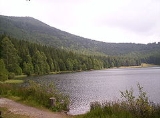
Lake Sfânta Ana
Encyclopedia
Lake Sfânta Ana (ˈsfɨnta ˈana; , meaning "Saint Anne Lake" in both languages) is the only crater lake
in Romania
located in the volcanic crater
named "Puciosul" (Büdös-hegy or Stinky Mountain) of the Eastern Carpathians, near Tuşnad
in the Natural Reserve of Mohoș, Harghita County
, Romania
.
Palynology
studies concluded that the history of Lake Saint Anne began about 9,800-8,800 years ago, at the stage of peat bog and shallow lake.
It has an oval form and an area of 220,000 m².
According to measurements made in 2005, the maximum depth of the lake is 6.4 m and the sediment thickness is about 4 m. The lake is supplied exclusively from precipitations, therefore the degree of mineralization of the water is very low. The water purity approaches of that of distilled water, with only 0.0029 ml mineral
In winter, the lake is covered with a layer of ice of up to 1 m
Near the lake there is a Roman Catholic chapel dedicated to Saint Anne.
Crater lake
A crater lake is a lake that forms in a volcanic crater or caldera, such as a maar; less commonly and with lower association to the term a lake may form in an impact crater caused by a meteorite. Sometimes lakes which form inside calderas are called caldera lakes, but often this distinction is not...
in Romania
Romania
Romania is a country located at the crossroads of Central and Southeastern Europe, on the Lower Danube, within and outside the Carpathian arch, bordering on the Black Sea...
located in the volcanic crater
Volcanic crater
A volcanic crater is a circular depression in the ground caused by volcanic activity. It is typically a basin, circular in form within which occurs a vent from which magma erupts as gases, lava, and ejecta. A crater can be of large dimensions, and sometimes of great depth...
named "Puciosul" (Büdös-hegy or Stinky Mountain) of the Eastern Carpathians, near Tuşnad
Baile Tusnad
Băile Tușnad is a town in Harghita County, Romania. It lies in the Székely Land, an ethno-cultural region in eastern Transylvania.With a population of 1,728, it is the smallest town in Romania by population...
in the Natural Reserve of Mohoș, Harghita County
Harghita County
Harghita is a county in the center of Romania, in eastern Transylvania, with the county seat at Miercurea-Ciuc.-Demographics:In 2002, it had a population of 326,222 and a population density of 52/km².*Hungarians- 85%...
, Romania
Romania
Romania is a country located at the crossroads of Central and Southeastern Europe, on the Lower Danube, within and outside the Carpathian arch, bordering on the Black Sea...
.
Palynology
Palynology
Palynology is the science that studies contemporary and fossil palynomorphs, including pollen, spores, orbicules, dinoflagellate cysts, acritarchs, chitinozoans and scolecodonts, together with particulate organic matter and kerogen found in sedimentary rocks and sediments...
studies concluded that the history of Lake Saint Anne began about 9,800-8,800 years ago, at the stage of peat bog and shallow lake.
It has an oval form and an area of 220,000 m².
According to measurements made in 2005, the maximum depth of the lake is 6.4 m and the sediment thickness is about 4 m. The lake is supplied exclusively from precipitations, therefore the degree of mineralization of the water is very low. The water purity approaches of that of distilled water, with only 0.0029 ml mineral
In winter, the lake is covered with a layer of ice of up to 1 m
Near the lake there is a Roman Catholic chapel dedicated to Saint Anne.

